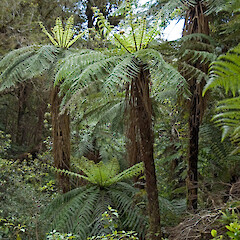Alsophila smithii
Common name
kātote, Smith’s tree fern, soft tree fern
Synonyms
Cyathea smithii Hook. f.; Hemitelia smithii (Hook.f.) Hook. ex Hook. et Baker
Family
Cyatheaceae
Flora category
Vascular – Native
Endemic taxon
Yes
Endemic genus
No
Endemic family
No
Structural class
Ferns
NVS code
The National Vegetation Survey (NVS) Databank is a physical archive and electronic databank containing records of over 94,000 vegetation survey plots - including data from over 19,000 permanent plots. NVS maintains a standard set of species code abbreviations that correspond to standard scientific plant names from the Ngä Tipu o Aotearoa - New Zealand Plants database.
CYASMI
Chromosome number
2n = 138
Current conservation status
The conservation status of all known New Zealand vascular plant taxa at the rank of species and below were reassessed in 2017 using the New Zealand Threat Classification System (NZTCS) – more information about this can be found on the NZTCS website. This report includes a statistical summary and brief notes on changes since 2012 and replaces all previous NZTCS lists for vascular plants.
Please note, threat classifications are often suggested by authors when publications fall between NZTCS assessment periods – an interim threat classification status has not been assessed by the NZTCS panel.
- Conservation status of New Zealand indigenous vascular plants, 2017 . 2018. Peter J. de Lange, Jeremy R. Rolfe, John W. Barkla, Shannel P. Courtney, Paul D. Champion, Leon R. Perrie, Sarah M. Beadel, Kerry A. Ford, Ilse Breitwieser, Ines Schönberger, Rowan Hindmarsh-Walls, Peter B. Heenan and Kate Ladley. Department of Conservation. Source: NZTCS and licensed by DOC for reuse under the Creative Commons Attribution 4.0 International licence.
2017 | Not Threatened
Previous conservation statuses
2012 | Not Threatened
2009 | Not Threatened
2004 | Not Threatened
Brief description
Tree fern with green-stalked soft leaves to 2.5 m long. Trunk to 5 m tall, skirted by the remains of old leaves. Leaf stems covered in small red and white star-shaped hairs and pointed scales (lens needed). Sporangia arranged in small round capsules underneath leaves.
Distribution
Endemic. New Zealand: North Island, South Island, Stewart Island/Rakiura, Chatham Islands, Auckland Islands.
Habitat
Lowland to montane (mostly montane in northern New Zealand), usually in dense forest where it is often a common subcanopy species, in wetter areas often extending in open scrub, gullies and valley heads, and within the bushline. In wetter areas Alsophila smithii often forms a tree-fern land in cut over and/or deer damaged indigenous forest, and it may be a common species in pine plantations.
Wetland plant indicator status rating
Information derived from the revised national wetland plant list prepared to assist councils in delineating and monitoring wetlands (Clarkson et al., 2021 Manaaki Whenua – Landcare Research Contract Report LC3975 for Hawke’s Bay Regional Council). The national plant list categorises plants by the extent to which they are found in wetlands and not ‘drylands’. The indicator status ratings are OBL (obligate wetland), FACW (facultative wetland), FAC (facultative), FACU (facultative upland), and UPL (obligate upland). If you have suggestions for the Wetland Indicator Status Rating, please contact: [Enable JavaScript to view protected content]
FACU: Facultative Upland
Occasionally is a hydrophyte but usually occurs in uplands (non-wetlands).
Detailed description
Trunks up to 8 m tall, 50–150 mm diameter, covered with appressed, dark brown stipe stubs. Stipes slender, pale to dark brown, finely rugose, bearing dark red-brown scales with entire margins devoid of spines. Fronds up to 2.5 m long, held horizontally, 3-pinnate, soft, delicate (wilting readily if picked or drought stressed), adaxially dark glossy green, abaxially paler; midribs of dead fronds long persistent as a short skirt around trunk. Longest primary pinnae 250–500 mm long, abaxial surface bearing numerous red and white stellate hairs, and scales with entire or sparingly spinose margins. Indusia saucer-shaped, surrounding sori only at bases when mature. (Description modified from Brownsey & Smith-Dodsworth (2000)).
Similar taxa
Easily recognised by the soft, delicate fronds, persistent grass-like skirt of dead stipes and rachises, and by the stipe and frond red-brown scales. Young plants are often confused with Alsophila cunninghamii which often grows in the same habitats. The scales of Alsophila cunninghamii are more variable than those of A. smithii, often golden-brown to yellow and terminated by a short (1 mm long) stiff bristle like seta.
Flowering
N.A.
Flower colours
No flowers
Fruiting
N.A.
Propagation technique
Easily grown but needs shelter from strong winds and must never be allowed to dry out. Does better in wetter parts of the country.
Etymology
smithii: After the British botanist John Smith (1798-1888) or Stephenson Percy Smith (1840-1922).
Attribution
Fact sheet prepared for NZPCN by P.J. de Lange (Updated 23 March 2011). Description modified from Brownsey & Smith-Dodsworth (2000).
References and further reading
Brownsey PJ, Smith-Dodsworth JC. 2000. New Zealand Ferns and Allied Plants. David Bateman, Auckland, NZ. 168 p.
NZPCN Fact Sheet citation
Please cite as: de Lange, P.J. (Year at time of access): Alsophila smithii Fact Sheet (content continuously updated). New Zealand Plant Conservation Network. https://www.nzpcn.org.nz/flora/species/alsophila-smithii/ (Date website was queried)








